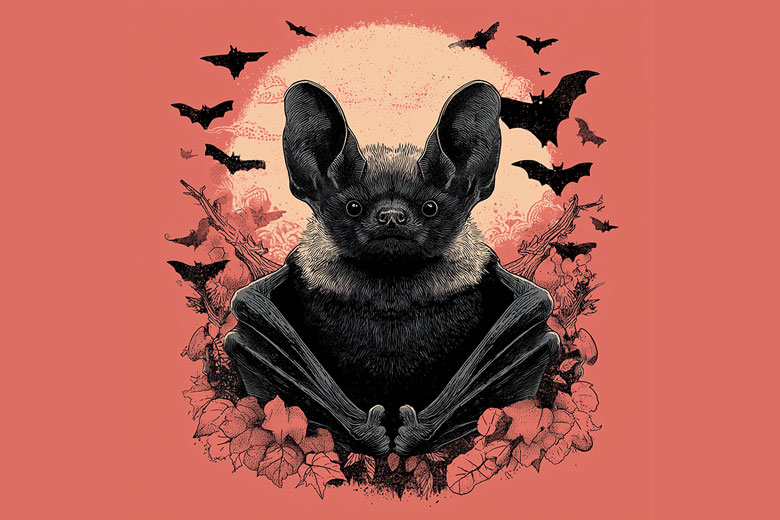The bat paradox: what nature’s night flyers could teach us about pandemics – and ourselves
Bats carry many deadly viruses, yet rarely fall ill themselves. Rather than fearing them, scientists say we should study and protect them, to safeguard our own health.
- 29 October 2025
- 11 min read
- by Linda Geddes

In the aftermath of COVID-19, the question of where the next pandemic might come from looms large. Increasingly, eyes turn to bats.
The diversity of deadly viruses these much-maligned mammals carry is astonishing – as is their ability to host at least some of them without falling ill.
“Bats also suffer certain diseases, but overall, they don't suffer disease like we do,” says Prof Linfa Wang, a virologist at Duke-NUS Medical School in Singapore. “They carry all these nasty viruses that are highly lethal when they jump – not only to humans, but to pigs, horses, cats, everything. But in bats, they don't even induce a fever.”
Bats have been blamed for some of the deadliest viruses to cross into humans – from SARS, Marburg and Nipah to COVID-19.
But the real danger isn’t the bats themselves; it’s how we interact with them. Human activities such as habitat destruction and the live animal trade amplify the risk of viral spillover and turn bats into a potential threat.
Far from being villains, these remarkable mammals – and their extraordinary immune systems – could provide insights into how to better manage disease and even inspire new medical therapies. But first, we need to learn to coexist with them safely.
What viruses do bats carry?
Wang’s journey into what he jokingly calls “batman” science began by accident. Trained as a molecular biologist, he stumbled into virology while investigating a string of equine deaths in Brisbane, Australia, during the mid-1990s.
“This mysterious virus came from nowhere, killing horses with 70% case fatality, and infecting humans – one death, one person in ICU – so it was highly lethal,” he recalls. Sequencing the virus, Wang identified a new pathogen: Hendra virus. But where did it come from?
After ruling out koalas, kangaroos, and many other animals, Wang and his colleagues hit a dead end. Then a further human death about 800 km north pivoted their attention to flying creatures – birds and bats – before they identified flying fox bats (a type of fruit bat) as the source.
Far from being villains, these remarkable mammals – and their extraordinary immune systems – could provide insights into how to better manage disease and even inspire new medical therapies. But first, we need to learn to coexist with them safely.
A few years later, a baffling outbreak in the Malaysian village of Sungai Nipah drew Wang’s attention again. Pigs were dying in alarming numbers and hundreds of farmers developed severe encephalitis (brain inflammation).
Blood samples from infected pigs, humans and wild animals eventually pointed to the same culprit: flying foxes.
Fruit trees planted near pig pens on the farms had lured bats to feed and drop contaminated fruit into the enclosures, triggering spillover to livestock and then farmers.
Then, in 2002–2003, an outbreak of atypical pneumonia – later named severe acute respiratory syndrome (SARS) – sickened 8,098 people and killed 774, triggering a worldwide scramble to contain it.
Investigations initially pointed to masked palm civets in China’s live animal markets as the likely source, but these proved to be intermediate hosts. Eventually, Wang and colleagues detected the sequence of a closely related virus from horseshoe bats, confirming them as the natural reservoir of SARS-like coronaviruses.
“Every time we traced these viruses back, we found bats,” Wang says.
While vampire bats have long been associated with rabies, and bats more broadly with Marburg virus, they have also been connected to MERS, SARS-CoV-2, and possibly Ebola. All of this raises the question, why bats?
What makes bats unique?
It’s not that bats necessarily carry more viruses than other animals. “So far, I haven’t seen strong evidence that bats carry a disproportionate number of viruses that infect people,” says Daniel Streicker, an infectious disease ecologist at the MRC-University of Glasgow Centre for Virus Research in Scotland.
“The interesting thing is that, at least for several viruses that cause severe disease in humans, bats don’t seem to be experiencing clinical disease when they’re infected.”
From a human perspective, that’s a problem. If bats can carry on as normal while infected – feeding, flying and mingling – they can potentially shed viruses over large areas, Increasing the risk of transmission to other species, including us.
Exactly how they manage this is still being pieced together, but the leading theory centres on flight.
Bats are the only mammals capable of sustained flight – an energetically demanding skill that sends heart rates soaring up to 1,000 beats per minute, raises body temperatures up to 42°C, and ramps us metabolism 15- to 30-fold.
Such extremes produce a flood of metabolic waste and inflammation that in most mammals would be deadly.
“Flight is stress,” Wang explains. “If you’re constantly under stress, you have to evolve – otherwise you die.” His theory is that, in adapting to the strains of flight, bats evolved the ability to override danger signals that would shut down other mammals’ bodies – a superpower that extends to their immune systems.
When humans catch infections, it’s often not the virus that kills us, but our immune systems.
Bats live in a perpetual state of immune readiness – with antiviral defences on high alert even in the absence of infection – yet rarely tip into damaging inflammation. They can tolerate viruses, even allow limited replication, without triggering the harmful cytokine storms that make humans severely ill.
Have you read?
“For laypeople, the best summary of the bat immune system is on one hand, they have a high base level of defence, and on the other, they have mechanisms to avoid over-defence,” Wang explains.
Arinjay Bannerjee, Principal Scientist at the University of Saskatchewan’s Vaccine and Infectious Disease Organization, has been studying these mechanisms.
He’s found that bat cells can sustain infection with MERS virus for months without dying, and don’t launch large inflammatory responses when challenged with other viruses. “This is key, because as we saw with COVID-19, inflammation was a key driver for disease severity,” Banerjee said.
His team also discovered that bats’ innate immune responses – the body’s first line of defence – act faster than in humans, and that a gene called GBP-1, which is switched on when the immune system detects a viral infection, appears more potent at shutting down viruses than the human version of it.
Bats respond early to viruses, reducing the need for excessive later inflammation. “It’s this combination that allows bats to tolerate some of these viruses,” Banerjee explains.
How do spillovers from bats to humans occur?
This paradox – that bats are both vaults of lethal viruses and masters of viral tolerance – makes them both frightening and inspiring. While spillovers are rare, when they do occur the consequences can be catastrophic. Recent human outbreaks of Nipah virus in Bangladesh, for instance, have had case fatality rates of 75–100%.
These Nipah outbreaks often occur when people consume raw date palm sap contaminated with urine or saliva from fruit bats, which are also drawn to the sweet sap in the harvesting devices.
However, such direct bat-to-human spillover of viruses is very rare. “It’s really bat-to-animal and then animal-to-human,” says Wang.
Even then, three conditions must align for these infections to occur: a virus must be circulating in bats, those bats must overlap spatially with another species, and there must be an exposure event – such as contact with bat urine, faeces or saliva.
“In Bangladesh, bats and humans overlap everywhere. But without bats licking date-palm sap and humans drinking it, there wouldn’t be an exposure event,” explains Raina Plowright, a veterinarian and epidemiologist at Cornell University in Ithaca, US, who studies the spillover of viruses from bats to other species.
Much of her research has focused on Hendra outbreaks in Australia, showing how human activity and environmental stress can tip the balance from coexistence to catastrophe. Flying foxes, the natural reservoirs of Hendra virus, once roamed nomadically across Australia, following the flowering cycles of native trees. But widespread deforestation and urbanisation have stripped away much of their habitat. “In some sites, 96% of all their winter habitat is gone. So, the bats get to winter and there’s no food,” Plowright says.
Her team’s data show that forest loss and food scarcity drive bats into urban and agricultural areas, where they overlap with horses – the intermediate hosts for Hendra virus. When native food is abundant, the bats feed in forests and outbreaks disappear. “But when native food disappears, the bats look for alternative food in areas where horses are present,” says Plowright.
Food shortages also appear to increase Hendra virus excretion, presumably because stress impairs immune control. “During one food shortage, between 40% to 60% of the urine samples we tested were positive for Hendra virus,” says Plowright. “We went from barely being able to find it, to finding it everywhere.”
She suspects that as bats lose access to native food and rely on suboptimal diets in urban and agricultural areas, they have less resilience to the effects of climate variation and viral shedding rises, increasing spillover risk. “When we have hot, dry conditions after a strong El Niño, viral shedding rises, especially in bat populations in novel habitats – and then we start to see more spillover events,” she says.
How can we reduce the threat posed by bat viruses?
“Bats carry viruses – that’s a fact,” says Wang. “But they don’t affect us, because bats and viruses have coexisted for millions of years. It’s only when humans disturb that balance that problems arise.”
Killing bats isn’t the answer. “Every study that's looked at killing bats in relation to viruses like Marburg and rabies has shown that it backfires,” says Plowright. “You end up getting more spillover events.”
Rabies offers a cautionary tale. In Latin America, vampire bats are often culled using an anticoagulant poison called vampiricide. “It reduces bites on livestock but does little to control rabies,” says Streicker. In some areas, culling may have even accelerated the virus’s spread as surviving bats disperse.
“Ideally, population control would rely on reproductive suppression rather than killing,” Streicker says. His team is also developing self-spreading vaccines – oral gels applied to bats’ fur and passed between them as they groom. “Bats are social animals; they lick each other a lot,” he adds.
Instead of killing, habitat protection is vital. “In Australia, only a handful of tree species provide food during the winter bottleneck time of year, and they have been heavily cleared. Protecting what's left is such an obvious step,” says Plowright. “The second priority is to restore what you can. That’s actually a win-win for everyone – farmers, biodiversity, even koalas, which use the same trees as bats.”
Banerjee adds: “Reducing wildlife-human conflict is step one, but should that not work, we need vaccines and therapeutics in place as well.” Two vaccines against Nipah virus are set to enter human trials in the coming months, but vaccines against other bat-associated viruses are needed.
Education is also key. “If you go to Bangladesh,” says Banerjee, “you will see massive posters on streets that tell people in the local language that if you’re consuming date palm sap, here are the risks. Monitor your symptoms and present yourself at the nearest hospital if you have flu-like symptoms, because oftentimes Nipah causes minor flu-like symptoms before it gets bad, very quickly.”
Could bats inspire human medicine?
As humans struggle to contain the disease that spill from nature, bats may yet offer solutions. Their finely tuned immune systems – dampening inflammation while remaining constantly vigilant – could inspire treatments for infectious diseases, ageing, cancer, diabetes and autoimmune disorders.
“All human diseases are rooted in over-inflammation,” Wang says. “Bats have evolved mechanisms to prevent this.”
His lab has identified proteins that help bats control over-inflammation and licensed them to a biotech start-up, Paratus Sciences, which raised $100 million in 2022 to develop human therapies based on bat biology. “The exciting part,” says Wang, “is that bats could be the saviours of human health.”
Banerjee agrees. “If we were to identify a full set of processes that bats have evolved to control infection, and we could simulate that response in humans, we might be able to achieve that ‘let’s not die post-infection’ situation.”
How could we live in harmony with bats?
The story of bats and viruses is ultimately one of balance: within their immune systems, within ecosystems and in how humans choose to coexist with wildlife.
As humans encroach on natural environments, bats are under growing pressure, and their energetic requirements may make them especially vulnerable to human-induced stress.
“Some bat species must replace half of their fat reserves every night,” says Plowright. “If food becomes scarce, that’s a very precarious situation. It makes them particularly sensitive to habitat loss and degradation.”
The solution, Plowright says, is coexistence, not conflict. “If we leave bats alone and provide them with the food and land they need, it protects us as well. Bats are critical pollinators, seed dispersers and insect eaters. We need to look after them – so that they can look after us.”








